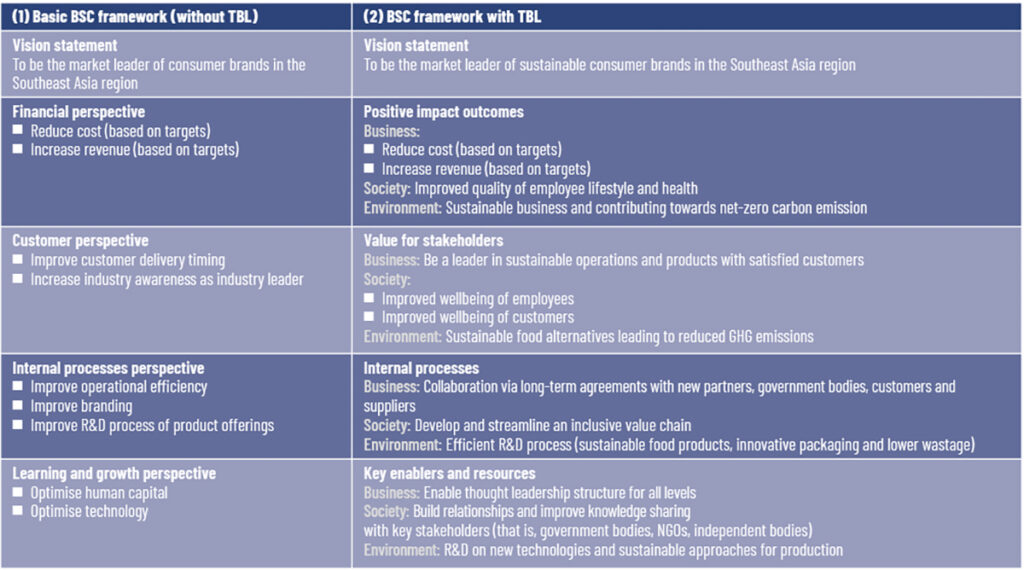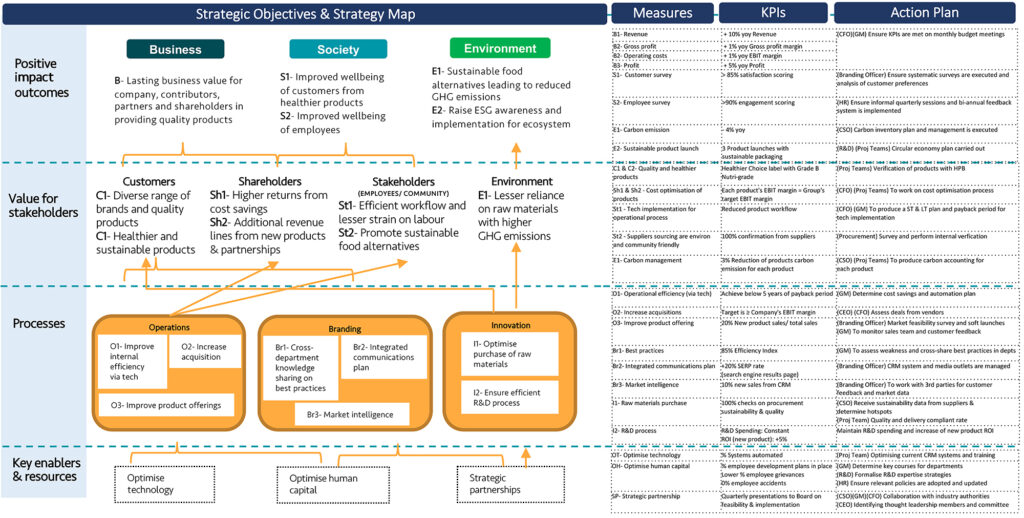


TAKEAWAYS
What does strategy mean for companies? Put simply, strategy is as much about making choices as it is about taking action to achieve long-term business goals. In practice, the process of formulating a strategy begins with decision-makers gaining a clear understanding of the current situation, envisioning what is possible, and devising a plan to achieve the desired outcome. An effective strategy would align a company’s vision with its implementation, and involves decision-makers making tough decisions that may lie outside their comfort zone, all with the aim of creating value.
Strategic planning is especially crucial for small and medium-sized enterprises (SMEs) and startups as they operate in highly competitive environments and face numerous challenges, including limited resources, financial constraints, and market uncertainties. Strategic planning, when done right, enables SMEs and startups to analyse their current position, set achievable objectives, and develop a roadmap for value creation and long-term success.
In order to achieve lasting success and longevity in business, companies should now consider developing strategies that generate value for not just their shareholders but also for their key stakeholders. This shift is evident in the growing concern among consumers about the impact of their consumption on the environment and society. As a result, companies are increasingly adopting sustainable practices while seeking profits, and are also mindful of their social and environmental impact.
Consumers have traditionally based their choices of products and services on factors such as price, quality and functionality. Companies, too, have been relying on these considerations to give them a competitive edge – simply because these are what their customers want. However, consumer patterns have evolved and today, consumers are increasingly looking for companies that demonstrate a strong commitment to social and environmental responsibility. This means that companies that focus only on price, quality and functionality are no longer able to fulfil the evolving expectations of consumers.
In order to gain a competitive advantage, it is important for companies to implement business strategies that consider sustainability factors and disclose their performance accordingly. Many listed companies and multinational corporations have adopted the triple-bottom-line (TBL) approach to report on their sustainability practices and performance. This approach places importance on not only profit but also the welfare of people and the preservation of the environment. Research has also shown that companies that prioritise the TBL approach, versus the traditional bottom-line approach, are more likely to achieve sustainable competitive advantages in the long term, compared to those that solely concentrate on financial gains.
The upcoming section will focus on the Balance Scorecard (BSC), a popular strategic management tool utilised by organisations and government bodies. This tool serves to communicate strategy, and offers a managing and measurement system that is widely adopted by thousands of entities.
Companies are familiar with the use of financial metrics to measure their financial health and achieve their financial goals. Often, when management behaviour and performance are driven solely by a financial perspective, they may over-emphasise short-term performance over long-term success. To do well in the long term, companies should consider a more balanced view. That is why the BSC, a strategic management tool, was devised and introduced by Robert S. Kaplan and David P. Norton in 1992. One of the key features of a BSC is that it uses four perspectives in measuring a company’s health to ensure long-term performance (Figure 1). The four perspectives are:
(1) Learning and growth perspective;
(2) Internal process perspective;
(3) Customer perspective, and
(4) Financial perspective.
When done properly, the BSC can be used to determine a company’s health based on the four perspectives, and put its strategy into context. Thereafter, sub-factors such as measures, targets and action plans are incorporated into each primary perspective to identify the critical success factors (CSF).
It is recommended for businesses to initiate the BSC process in this order: (1) Learning and growth perspective; (2) Internal process perspective; (3) Customer perspective and lastly, (4) Financial perspective. Progression through each perspective and identifying the key objectives will help identify the real drivers and unlock the potential for achieving long-term success.
Figure 1 Four primary perspective of a BSC

In this article, we will analyse the impact of a BSC on a fictitious SME called MeatCo Ltd, which specialises in the manufacturing of meat products in the Southeast Asia region. We will start by introducing the BSC framework with the use of a strategy map and after that, the BSC strategy map with the incorporation of the TBL concept. Finally, we will look at a one-page comprehensive BSC report that includes the BSC strategy map with the TBL concept, with sub-factors such as measures, targets, and action plans. In summary, the case study flows like this:
1) BSC strategy map;
2) BSC strategy map with TBL;
3) BSC strategy map with TBL and sub-factors (that is, measures, targets and action plans).
(1) Implementation of BSC strategy map
A BSC strategy map is a visual map that illustrates the cause-and-effect relationships between the objectives of each perspective (Figure 3); it helps companies visualise how their activities contribute to the overall strategy. Strategy maps should be kept simple and straightforward as they should tell leadership and employees how the company is performing at achieving its strategy at a glance.
Figure 2

Benefits of a BSC strategic map
Figure 3

(2) Implementation of BSC strategy map with TBL
As earlier discussed, the four primary perspectives and objectives are ultimately orientated towards shareholder and corporate profitability. To adjust the orientation towards key stakeholders and sustainable profitability, companies should consider environmental and societal impacts in achieving their financial outcomes. In this section, we will discuss the different objectives (taking into consideration the TBL concept) when implementing the BSC framework and BSC strategy map.
In Figure 4, we will look at the difference in vision statements and objectives for each perspective for the (1) Basic BSC framework, and (2) BSC framework with TBL.
Figure 4

Illustration of BSC strategy map with TBL
Figure 5 shows what a BSC strategy map with TBL looks like.
Figure 5

(3) Implementation of BSC strategy map with TBL & sub-factors (that is, measures, targets, and action plans)
After preparing the BSC strategy map with TBL, the company can align its vision, values and mission statements, and set suitable strategic themes for the desired results they target to achieve.

Defining measures, key performance indicators (KPIs), and action plans
At this stage, using a two-way feedback approach (that is, top-down and bottom-up) with the department’s management would be useful. This will aid in understanding the on-the-ground context regarding the right measures for each objective, and the setting of KPIs and action plans for each of the departments or personnel responsible for the objective(s) (Figure 6).
Figure 6

This article explains what strategic planning is and provides an introduction of the BSC for SMEs and startups. It shows how a BSC can be used as a tool for strategic management and communication, as well as a measurement system for the company’s vision.
In the upcoming articles, we will discuss how to implement a BSC, share some tips for the successful implementation of strategies from leaders and CEOs, and the challenges that SMEs and startups may face as compared to multinational companies and listed companies.
This is the first of a three-part series on strategy planning and implementation for SMEs and startups. Look out for Parts 2 and 3 in the upcoming journal issues.
David Yeong is Partner of Consulting, SAC Capital Private Ltd; Keith Tan is Director of Business Consulting, RSM Risk Advisory Pte Ltd.